Figures & data
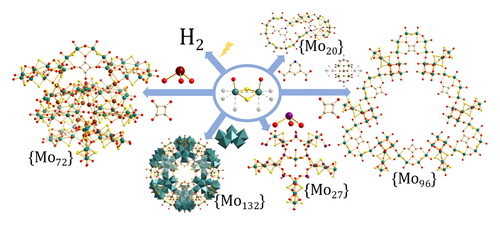
Figure 1. Structures of the three build blocks used in POTMs. a) [MoV2O2(µ-S)2]2+, b) [WV2O2(µ-S)2]2+ and c) [MoIV3(µ3-S)(µ-S)]4+. Mo, teal; W, blue; O, red; S yellow; open coordination faces highlighted with translucent grey atoms.
![Figure 1. Structures of the three build blocks used in POTMs. a) [MoV2O2(µ-S)2]2+, b) [WV2O2(µ-S)2]2+ and c) [MoIV3(µ3-S)(µ-S)]4+. Mo, teal; W, blue; O, red; S yellow; open coordination faces highlighted with translucent grey atoms.](/cms/asset/33514f31-6009-4154-86e0-c7e9a6492ce7/gcoo_a_2086049_f0001_c.jpg)
Figure 2. Schematic representation of the self-condensation process of [MoV2O2(µ-S)2(H2O)6]2+ as a result of increased pH.
![Figure 2. Schematic representation of the self-condensation process of [MoV2O2(µ-S)2(H2O)6]2+ as a result of increased pH.](/cms/asset/16517a57-33f7-4e0d-9bdf-536d1bacb5b7/gcoo_a_2086049_f0002_c.jpg)
Figure 3. Crystal structures of the POTM rings described in this section. A) {Mo16(IsoP)2}, {Mo16(abtc)}, {Mo16(abtc)2}; B) {Mo14(C4O4)2}, {Mo16(C4O4)2K2}, {Mo12(AcO)2}; C) {Mo10}n{thiophenediphosphonate}n; D) {Mo16(DFMT)}, {Mo12(DMT)}. (IsoP = isopthalate, abtc = 3,5-dicarboxyl-(3’,5’-dicarboxyazophenyl), DFMT = 2,5-bis(trifluoro)methylterephthalate, DMT = 2,5-dimethylterephthalate). Formulas are given in shorthand for clarity. Mo, teal; N, blue; O, Red; P, purple; C, white; S, yellow; K, grey; F, green.
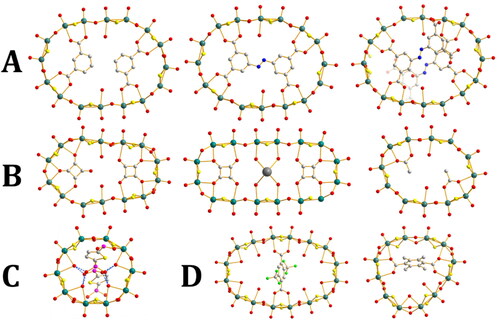
Figure 4. Crystal structures of the POTMs described in this section. A) {Mo8S8(Ale)4}, {Mo8S8(Zol)4}, {Mo8O8(Ale)4}; B) {Mo4(Tart)2}; C) {Mo20(PyD)2}; D) {MoV8S8(MoVI8)4}; E) {WVI72MoV60S60}, {MoVI72MoV60S60}; F) {(MoV6S6)8(MoVI3)12}, {(MoVI17)3MoV12S6} (Ale = alendronic acid, Zol = zoledronic acid, Tart = tartarate (racemic), PyD = 3,5-pyridinedicarboxylic acid). Formulas are given in shorthand for clarity. Mo, teal (MoV, spheres, MoVI polyhedra); W, dark blue polyhedra, N, blue spheres, O, red; C, white; S, yellow; Rb, green; hydrogen omitted for clarity.
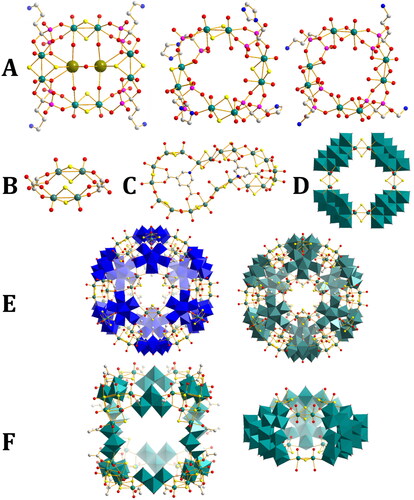
Figure 5. Building blocks used in squarate/molybdate system. A) [MoV2O2(µ-S)2]2+, B) Squarate ([C4O4]2–), C) Square-type building block, D) Diamond-type building block, E) [MoVI2O8]4–, F) Lindqvist fragment [MoVI5O18]6– top-down and side-on views, G) Pentagonal fragment [MoVI6O21]5– top-down and side-on views. Mo, teal; O, red; S, yellow; C, white; coordination positions shown as translucent grey.
![Figure 5. Building blocks used in squarate/molybdate system. A) [MoV2O2(µ-S)2]2+, B) Squarate ([C4O4]2–), C) Square-type building block, D) Diamond-type building block, E) [MoVI2O8]4–, F) Lindqvist fragment [MoVI5O18]6– top-down and side-on views, G) Pentagonal fragment [MoVI6O21]5– top-down and side-on views. Mo, teal; O, red; S, yellow; C, white; coordination positions shown as translucent grey.](/cms/asset/640d9643-6dda-4102-968e-a7a07fa26c28/gcoo_a_2086049_f0005_c.jpg)
Figure 6. Squarate/[MoVI2O8]4– system showing how the building blocks can assemble into A) {MoV12(C4O4)2(MoVI2O8)2}, B) {MoV8(C4O4)(MoVI2O8)} or C) {MoV8(C4O4)(MoVIO4)2}. Mo, teal; O, red; S, yellow; C, white; coordination positions shown as translucent grey.
![Figure 6. Squarate/[MoVI2O8]4– system showing how the building blocks can assemble into A) {MoV12(C4O4)2(MoVI2O8)2}, B) {MoV8(C4O4)(MoVI2O8)} or C) {MoV8(C4O4)(MoVIO4)2}. Mo, teal; O, red; S, yellow; C, white; coordination positions shown as translucent grey.](/cms/asset/356e2c78-3661-48df-a79a-e2392965fe4a/gcoo_a_2086049_f0006_c.jpg)
Figure 7. Squarate/[MoVI5O18]6– system showing how the building blocks can assemble into A) {MoV30(C4O4)5(MoVI5O18)3}, B) {MoV32(C4O4)5(MoVI5O18)3}, C) {MoV40(C4O4)7(MoVI5O18)3}, D) {MoV66(C4O4)12(MoVI5O18)6} or E) {MoV48(C4O4)8(MoVI5O18)4}. Mo, teal; O, red; S, yellow; C, white; Coordination positions shown as translucent grey. Red arrows indicate structural relationship and do not necessarily indicate reaction pathway.
![Figure 7. Squarate/[MoVI5O18]6– system showing how the building blocks can assemble into A) {MoV30(C4O4)5(MoVI5O18)3}, B) {MoV32(C4O4)5(MoVI5O18)3}, C) {MoV40(C4O4)7(MoVI5O18)3}, D) {MoV66(C4O4)12(MoVI5O18)6} or E) {MoV48(C4O4)8(MoVI5O18)4}. Mo, teal; O, red; S, yellow; C, white; Coordination positions shown as translucent grey. Red arrows indicate structural relationship and do not necessarily indicate reaction pathway.](/cms/asset/807d2d6d-948f-4594-9e25-977e32e29605/gcoo_a_2086049_f0007_c.jpg)
Figure 8. Squarate/[MoVI(MoVI5)O21]5– system and related systems with croconate. Colored circles represent the components present in the conditions that give the indicated product. A) {MoV18(C4O4)9}, B) {MoV10(C5O5)}, C) {MoV2(C5O5)} co-crystallized with {MoVI12(C4O4)4}, D) {MoV36(C4O4)4(MoVI(MoVI5))2}, E) {MoV48(C4O4)6(MoVI(MoVI5))2}, F) {MoV48(C4O4)6(MoVI(MoVI5))2} co-crystallized with {MoVI12(C4O4)4}. Mo, teal; O, red; S, yellow; C, white; coordination positions shown as translucent grey. Red arrows indicate structural relationship and do not necessarily indicate reaction pathway.
![Figure 8. Squarate/[MoVI(MoVI5)O21]5– system and related systems with croconate. Colored circles represent the components present in the conditions that give the indicated product. A) {MoV18(C4O4)9}, B) {MoV10(C5O5)}, C) {MoV2(C5O5)} co-crystallized with {MoVI12(C4O4)4}, D) {MoV36(C4O4)4(MoVI(MoVI5))2}, E) {MoV48(C4O4)6(MoVI(MoVI5))2}, F) {MoV48(C4O4)6(MoVI(MoVI5))2} co-crystallized with {MoVI12(C4O4)4}. Mo, teal; O, red; S, yellow; C, white; coordination positions shown as translucent grey. Red arrows indicate structural relationship and do not necessarily indicate reaction pathway.](/cms/asset/aae2c500-2a1d-4bdb-aa09-9a89218cb9c3/gcoo_a_2086049_f0008_c.jpg)
Figure 9. Reaction coordinates of the selenite POTM system. Structures are positioned according to relative relationship between pH and Se:Mo ratio required for formation. The position does not reflect exact pH or Se:Mo values. A) {MoV27(SeO3)17}, B) {MoV16(SeO3)20}, C) {MoV16(SeO3)} and D) {MoV36(SeO3)6}. Mo, teal; O, red; S, yellow; C, white; Se, purple; coordination positions shown as translucent grey. Red arrows indicate structural relationship and do not necessarily indicate reaction pathway.
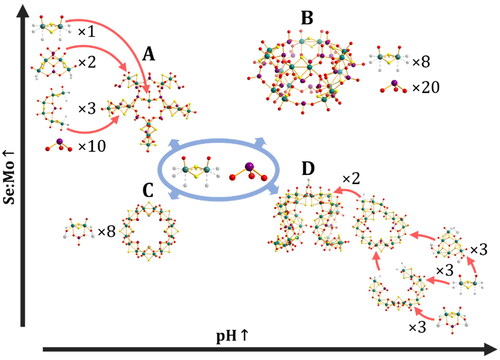
Figure 10. Structures mentioned in this section that do not belong to a specific system of building blocks. A) {MoV12(SO3)16}, B) {MoV12(WVI14Se2O52)3}, C) {MoV16(WVI14Se2O52)5WVI22}. Mo, teal; W, blue polyhedra; O, red; S, yellow; C, white; Se, purple; coordination positions shown as translucent grey.
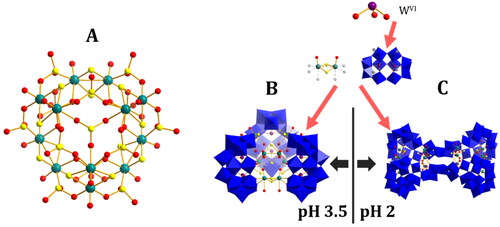
Figure 11. Combination of [MoV2O2(µ-S)2]2+ and tellurite, with (bottom) and without (top) squarate. Colored circles show the building blocks that join to give the structures. A) {MoV8(TeO3)}, B) {MoV24(TeO3)}, C) {MoV20(TeO3)(Te2(µ-O)2O4)(Te2(µ-O)O5)}, D) {MoV24(C4O4)4(TeO4)2}, E) {MoV30(C4O4)3(TeO4)3}, F) {MoV28(C4O4)4(TeO4)2} and G) {MoV72(C4O4)8(Te3O10)4}. Mo, teal; O, red; S, yellow; C, white; Te, brown; Coordination positions shown as translucent grey. Red arrows indicate structural relationship and do not necessarily indicate reaction pathway.
![Figure 11. Combination of [MoV2O2(µ-S)2]2+ and tellurite, with (bottom) and without (top) squarate. Colored circles show the building blocks that join to give the structures. A) {MoV8(TeO3)}, B) {MoV24(TeO3)}, C) {MoV20(TeO3)(Te2(µ-O)2O4)(Te2(µ-O)O5)}, D) {MoV24(C4O4)4(TeO4)2}, E) {MoV30(C4O4)3(TeO4)3}, F) {MoV28(C4O4)4(TeO4)2} and G) {MoV72(C4O4)8(Te3O10)4}. Mo, teal; O, red; S, yellow; C, white; Te, brown; Coordination positions shown as translucent grey. Red arrows indicate structural relationship and do not necessarily indicate reaction pathway.](/cms/asset/d3dfcdb6-c7a3-4ada-b880-340c3120bd8f/gcoo_a_2086049_f0011_c.jpg)
Figure 12. POTM structures that have been used as HER electrocatalysts. A) [MoV2O2(µ-S)2(S2)2]2-, [MoV2O2(µ-S)2(S2)(S4)]2-, [WV2O2(µ-S)2(S2)(S4)]2-, B) {MoV8Ox}, {MoV12BTC}, C) {MoV20PyD2}, {Mo12Nap}, D) {MoV8S8Ale4}, E) {MoV18(MoIV3S4(nta)3)}, {MoV12(Ni(DTO)2)}, F) {Mo12TMT}, no crystal structure exists for {Mo12DFMT} (Ox = oxalate, BTC = benzenetricarboxylate, PyD = 3,5-pyridinedicarboxylate, Nap = 1,4-napthalenedicarboxylate, Ale = alendronic acid, nta = nitrilotriacetate, DTO = dithiooxalate, TMT = tetramethylterephthalate, DFMT = di-trifluoromethylterephthalate). Mo, teal; N, blue; O, red; S, yellow; C, white; Rb, green; W, dark blue; hydrogen omitted for clarity.
![Figure 12. POTM structures that have been used as HER electrocatalysts. A) [MoV2O2(µ-S)2(S2)2]2-, [MoV2O2(µ-S)2(S2)(S4)]2-, [WV2O2(µ-S)2(S2)(S4)]2-, B) {MoV8Ox}, {MoV12BTC}, C) {MoV20PyD2}, {Mo12Nap}, D) {MoV8S8Ale4}, E) {MoV18(MoIV3S4(nta)3)}, {MoV12(Ni(DTO)2)}, F) {Mo12TMT}, no crystal structure exists for {Mo12DFMT} (Ox = oxalate, BTC = benzenetricarboxylate, PyD = 3,5-pyridinedicarboxylate, Nap = 1,4-napthalenedicarboxylate, Ale = alendronic acid, nta = nitrilotriacetate, DTO = dithiooxalate, TMT = tetramethylterephthalate, DFMT = di-trifluoromethylterephthalate). Mo, teal; N, blue; O, red; S, yellow; C, white; Rb, green; W, dark blue; hydrogen omitted for clarity.](/cms/asset/f5a46500-c85c-4a22-8c33-fcc2291b5f82/gcoo_a_2086049_f0012_c.jpg)
